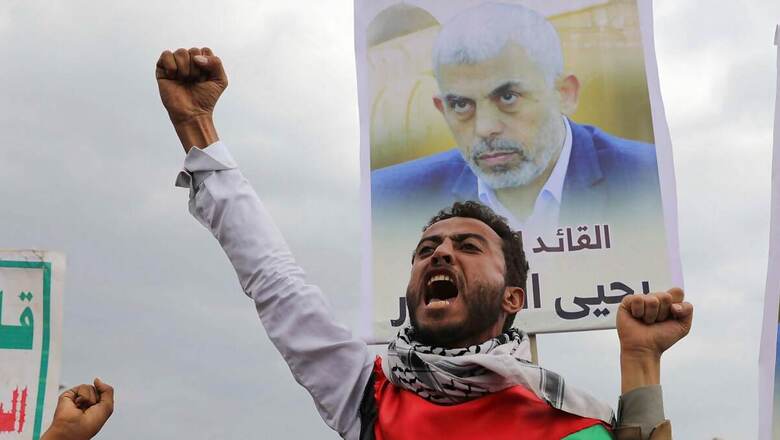'Big Project': Hamas Planned An Assault Deadlier Than October 7 And Sought Help From Iran, Hezbollah

views
Hamas had planned a far deadlier assault than the October 7 attack on Israel, which it delayed to seek help from Iran and Hezbollah, according to documents obtained by US media outlets. The Palestinian group had originally planned the assault before 2023 but postponed it to coordinate with these allies, according to The New York Times.
The report said that it had access to minutes from ten meetings held between January 2022 and August 2023, detailing the logistics of the attack. These documents were discovered earlier this year on a computer in a Hamas control center in Khan Younis. The report verified their authenticity and also obtained an internal report from the Israel Defense Forces (IDF) confirming the findings.
‘The big project’
The Hamas plans involved a cross-border attack targeting both military and civilian sites in Israel. Initial discussions about this strategy began in January 2022, with Hamas officials underlining the need to focus on what they termed “the big project” while avoiding immediate conflict escalation.
Letters from Hamas chief Yahya Sinwar to Iranian officials, dated as early as June 2021, revealed requests for financial and military support for a large-scale assault on Israel. In the letters obtained by the US media outlets, Sinwar describes the extensive damage sustained by Hamas during clashes with Israel and asks the Iranians to make up for the losses and help the group prepare for much larger battles to come.
“We are in dire need of your standing with us with all strength, determination, support and backing; first to restore our strength and what has been exhausted in this confrontation or what has been targeted, and to develop our capabilities many times over,” he writes in the letter to Ismail Qaani, the leader of the Islamic Revolutionary Guard Corps’ Quds Force.
In the letters written in 2021, Hamas’s Gaza leader appealed to several senior Iranian officials, including the country’s supreme leader, Ali Khamenei, for additional financial and military support. “We promise you that we will not waste a minute or a penny unless it takes us toward achieving this sacred goal,” states a June 2021 letter with apparent signatures by Sinwar as well as five other Hamas officials, according to The Washington Post.
9/11 Style Attack
As planning progressed over months, several attack scenarios were discussed, including potential targets such as shopping malls and military command centers. According to WAPO, one ambitious proposal involved a September 11-style attack on the Azrieli Towers in Tel Aviv, though this plan was ultimately discarded due to concerns about feasibility.
By September 2022, Hamas appeared ready to execute its plan, which involved attacking military bases before targeting civilian areas. However, the assault did not occur until October 7, 2023. The delay was attributed to ongoing efforts to secure Iranian and Hezbollah support. In August 2023, Sinwar’s deputy met with an Iranian official to discuss operational details for the planned attack.
Although both Iran and Hezbollah voiced support for the attack, they needed more time for preparation, according to the reports. Ultimately, Hamas proceeded without direct help from these allies but launched its assault as planned. On October 7, Hamas executed its deadly operation, resulting in the killing of over 1,200 people across southern Israel and the abduction of some 250 individuals.
Lebanon escalation
This report comes as the Middle East conflict has escalated, with casualties in Gaza mounting to 42,000. The war has now spread to Iran and Lebanon, with fears of further escalation in anticipation of Israel’s response to Tehran’s recent ballistic missile attack. Since Israel launched its ground invasion of Lebanon, Israeli forces and Hezbollah militants have clashed along the border while the Lebanese army has largely stood on the sidelines.
Israeli forces and Hezbollah fighters have been clashing since Oct. 8, 2023, when the Lebanese militant group began firing rockets over the border in support of its ally Hamas in Gaza. In recent weeks, Israel has conducted a major aerial bombardment of Lebanon and a ground invasion that it says aims to push Hezbollah back from the border. As Israeli troops made their first forays across the border and Hezbollah responded with rocket fire, Lebanese soldiers withdrew from observation posts along the frontier and repositioned about 5 kilometers back.
So far, Israeli forces have not advanced that far. The only direct clashes between the two national armies were on Oct. 3, when Israeli tank fire hit a Lebanese army position in the area of Bint Jbeil, killing a soldier, and on Friday when two soldiers were killed in an airstrike in the same area. The Lebanese army said it returned fire both times.
(With agency inputs)


















Comments
0 comment